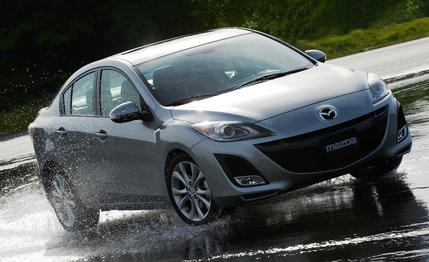
 First Drive Review
First Drive Review
Mazda gave itself a tough act to follow. The original Mazda 3 that launched in 2004 was an exceptional small car that delivered good fuel economy without sacrificing driving dynamics. That first-generation 3 didn’t skimp on refinement or interior quality, either. Rich plastics, unique design, and a luxurious array of optional equipment made the 3 a luxury sport sedan in a class full of mundane transportation devices. Now with the launch of the next-generation 3, would Mazda keep these attributes for its replacement?
New Styling
Much to our relief, the sequel to the original 3 maintains what we liked and even manages to improve on the original. The exterior styling is completely new, but various Mazda traits make the sedan immediately recognizable as a Mazda 3. Front-end styling cues borrowed from the Mazda RX-8 modernize the nose and help the 2010 3 confidently assert itself. Its flared front fenders and a sweeping character line at the base of the doors are subtle and attractive touches that make the old 3 look dated by comparison. Only the sedan version debuted at the 2008 Los Angeles auto show. A five-door hatchback will be shown at the Bologna auto show in early December.
Interior styling has also been modernized, but the curvaceous new dashboard doesn’t go so far as to stray into the realm of the Honda Civic’s spaceship console. Two large round gauges housing the tachometer and the speedometer remain in front of the driver, with radio and trip computer readouts moving to the top of the dashboard. In models equipped with navigation, a small color screen is nestled into the space formerly occupied by the trip computer. Several Chiclets-size buttons that control vehicle settings, the trip computer, the stereo, and the navigation system are confusingly arrayed on the steering-wheel spokes and take some time to learn.
Under the Skin and Behind the Wheel
The C1 architecture carries over from the previous 3 but with a host of upgrades that stiffen the structure without adding weight. Additional bracing for the suspension attachment points and an increase in the use of high-strength steel result in greater strength while avoiding a weight increase. Mazda claims the body in white (the bare unibody structure without any mounted body panels) is now 24.2 pounds lighter, and despite increased content, the 3 weighs only a few more pounds and is essentially the same size as the outgoing model. The wheelbase and the width are unchanged, and the overall length has increased by a couple of inches. The height is down by a few fractions of an inch, and the interior volume is unchanged over that of the previous 3, although trunk space has increased.